Case Study: Analyzing Joyce's Health Issues - A Comprehensive Review
VerifiedAdded on 2022/10/07
|12
|2735
|14
Case Study
AI Summary
This case study examines the health challenges faced by Joyce, a 77-year-old woman residing in a nursing home. The analysis focuses on Joyce's prolonged recovery from falls and fractures, interpreting it in terms of impaired wound healing due to aging and loss of skin integrity. The study delves into the effects of aging on the integumentary system, discussing the slow wound healing process. It also explores the impact of various medications on Joyce, particularly those causing diarrhea and constipation, and recommends dietary changes to alleviate these issues. Furthermore, the case study addresses Joyce's diagnosis of osteoporosis, exploring the factors contributing to the condition and the potential ineffectiveness of vitamin D and calcium supplementation due to her age and weakened digestive system. The document references multiple studies to support its findings and recommendations.
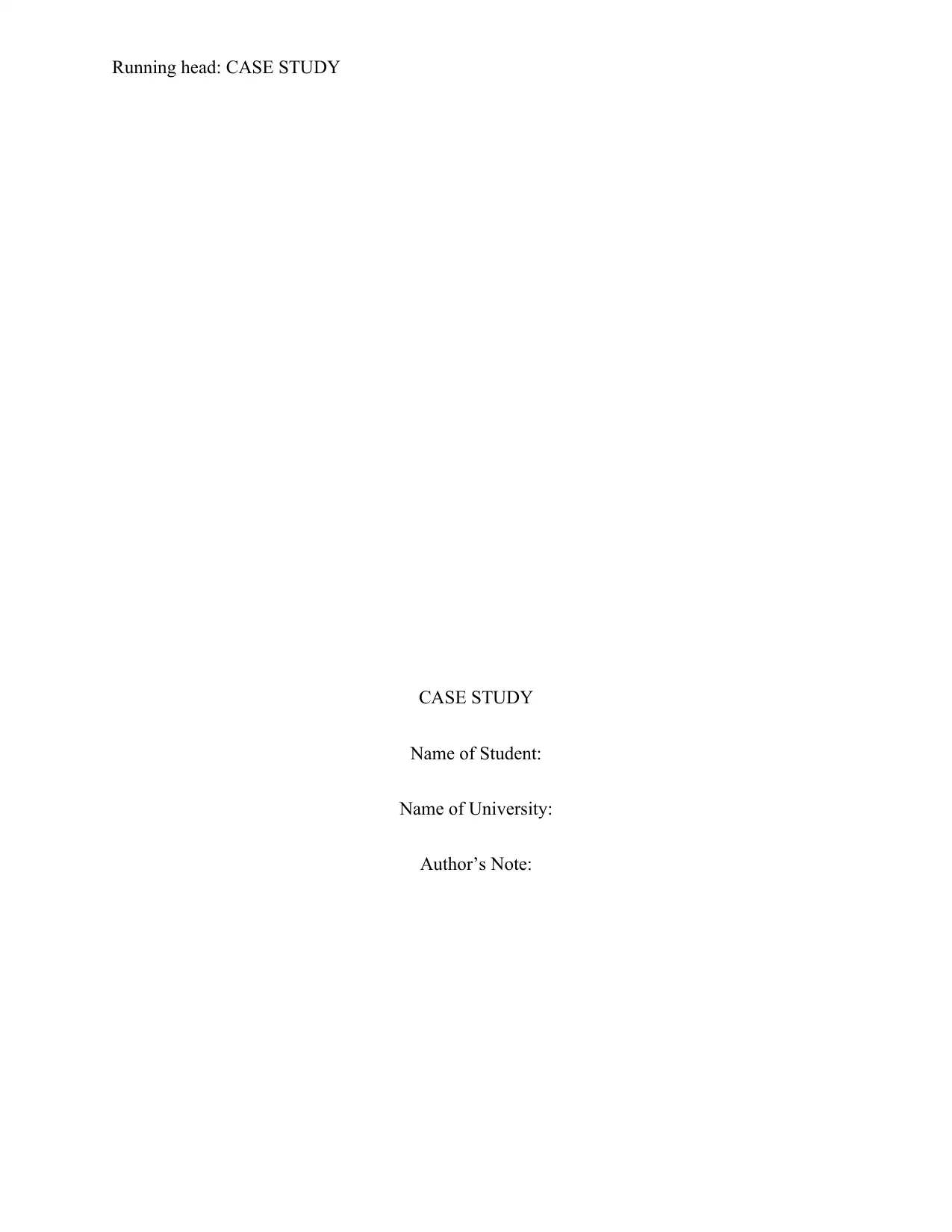
Running head: CASE STUDY
CASE STUDY
Name of Student:
Name of University:
Author’s Note:
CASE STUDY
Name of Student:
Name of University:
Author’s Note:
Paraphrase This Document
Need a fresh take? Get an instant paraphrase of this document with our AI Paraphraser
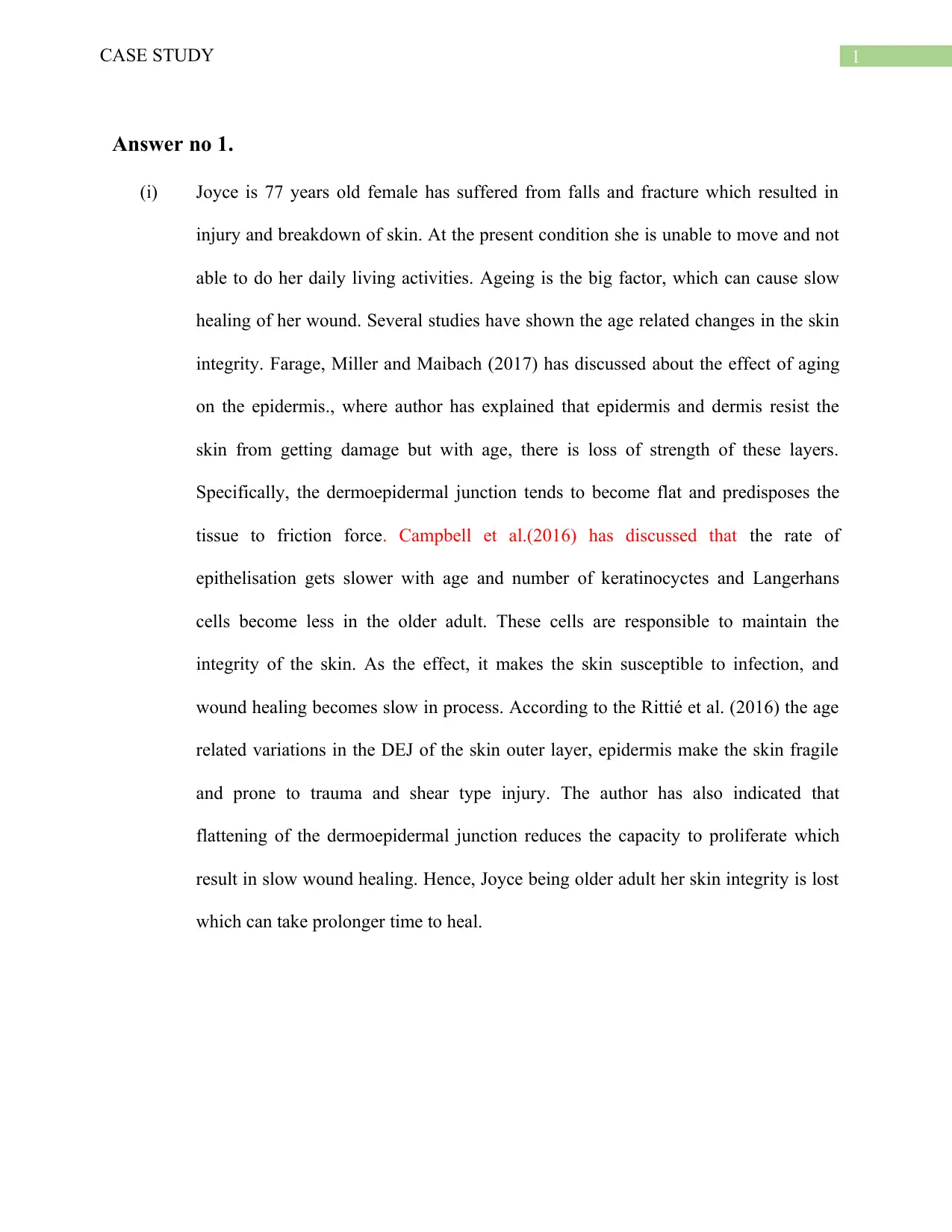
1CASE STUDY
Answer no 1.
(i) Joyce is 77 years old female has suffered from falls and fracture which resulted in
injury and breakdown of skin. At the present condition she is unable to move and not
able to do her daily living activities. Ageing is the big factor, which can cause slow
healing of her wound. Several studies have shown the age related changes in the skin
integrity. Farage, Miller and Maibach (2017) has discussed about the effect of aging
on the epidermis., where author has explained that epidermis and dermis resist the
skin from getting damage but with age, there is loss of strength of these layers.
Specifically, the dermoepidermal junction tends to become flat and predisposes the
tissue to friction force. Campbell et al.(2016) has discussed that the rate of
epithelisation gets slower with age and number of keratinocyctes and Langerhans
cells become less in the older adult. These cells are responsible to maintain the
integrity of the skin. As the effect, it makes the skin susceptible to infection, and
wound healing becomes slow in process. According to the Rittié et al. (2016) the age
related variations in the DEJ of the skin outer layer, epidermis make the skin fragile
and prone to trauma and shear type injury. The author has also indicated that
flattening of the dermoepidermal junction reduces the capacity to proliferate which
result in slow wound healing. Hence, Joyce being older adult her skin integrity is lost
which can take prolonger time to heal.
Answer no 1.
(i) Joyce is 77 years old female has suffered from falls and fracture which resulted in
injury and breakdown of skin. At the present condition she is unable to move and not
able to do her daily living activities. Ageing is the big factor, which can cause slow
healing of her wound. Several studies have shown the age related changes in the skin
integrity. Farage, Miller and Maibach (2017) has discussed about the effect of aging
on the epidermis., where author has explained that epidermis and dermis resist the
skin from getting damage but with age, there is loss of strength of these layers.
Specifically, the dermoepidermal junction tends to become flat and predisposes the
tissue to friction force. Campbell et al.(2016) has discussed that the rate of
epithelisation gets slower with age and number of keratinocyctes and Langerhans
cells become less in the older adult. These cells are responsible to maintain the
integrity of the skin. As the effect, it makes the skin susceptible to infection, and
wound healing becomes slow in process. According to the Rittié et al. (2016) the age
related variations in the DEJ of the skin outer layer, epidermis make the skin fragile
and prone to trauma and shear type injury. The author has also indicated that
flattening of the dermoepidermal junction reduces the capacity to proliferate which
result in slow wound healing. Hence, Joyce being older adult her skin integrity is lost
which can take prolonger time to heal.
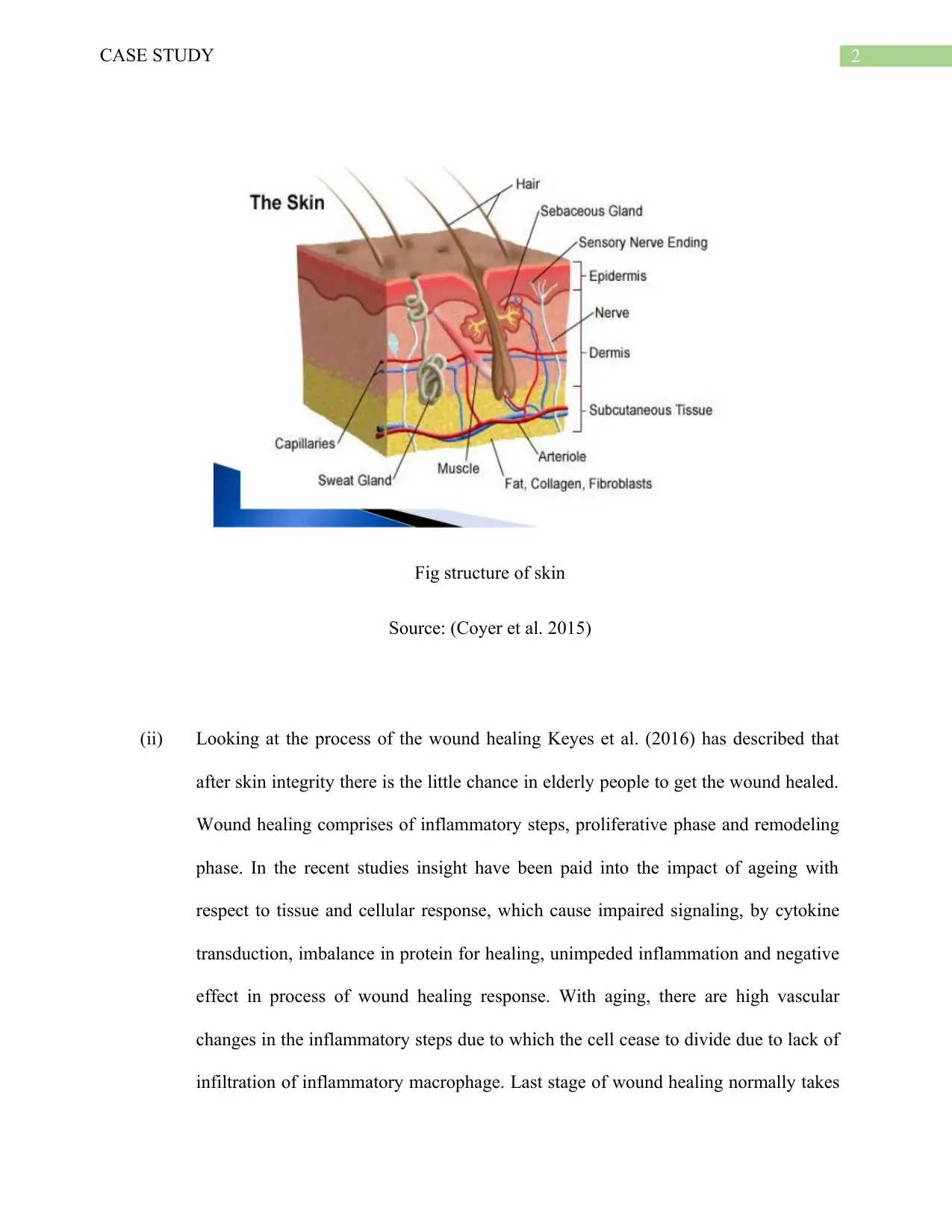
2CASE STUDY
Fig structure of skin
Source: (Coyer et al. 2015)
(ii) Looking at the process of the wound healing Keyes et al. (2016) has described that
after skin integrity there is the little chance in elderly people to get the wound healed.
Wound healing comprises of inflammatory steps, proliferative phase and remodeling
phase. In the recent studies insight have been paid into the impact of ageing with
respect to tissue and cellular response, which cause impaired signaling, by cytokine
transduction, imbalance in protein for healing, unimpeded inflammation and negative
effect in process of wound healing response. With aging, there are high vascular
changes in the inflammatory steps due to which the cell cease to divide due to lack of
infiltration of inflammatory macrophage. Last stage of wound healing normally takes
Fig structure of skin
Source: (Coyer et al. 2015)
(ii) Looking at the process of the wound healing Keyes et al. (2016) has described that
after skin integrity there is the little chance in elderly people to get the wound healed.
Wound healing comprises of inflammatory steps, proliferative phase and remodeling
phase. In the recent studies insight have been paid into the impact of ageing with
respect to tissue and cellular response, which cause impaired signaling, by cytokine
transduction, imbalance in protein for healing, unimpeded inflammation and negative
effect in process of wound healing response. With aging, there are high vascular
changes in the inflammatory steps due to which the cell cease to divide due to lack of
infiltration of inflammatory macrophage. Last stage of wound healing normally takes
⊘ This is a preview!⊘
Do you want full access?
Subscribe today to unlock all pages.

Trusted by 1+ million students worldwide
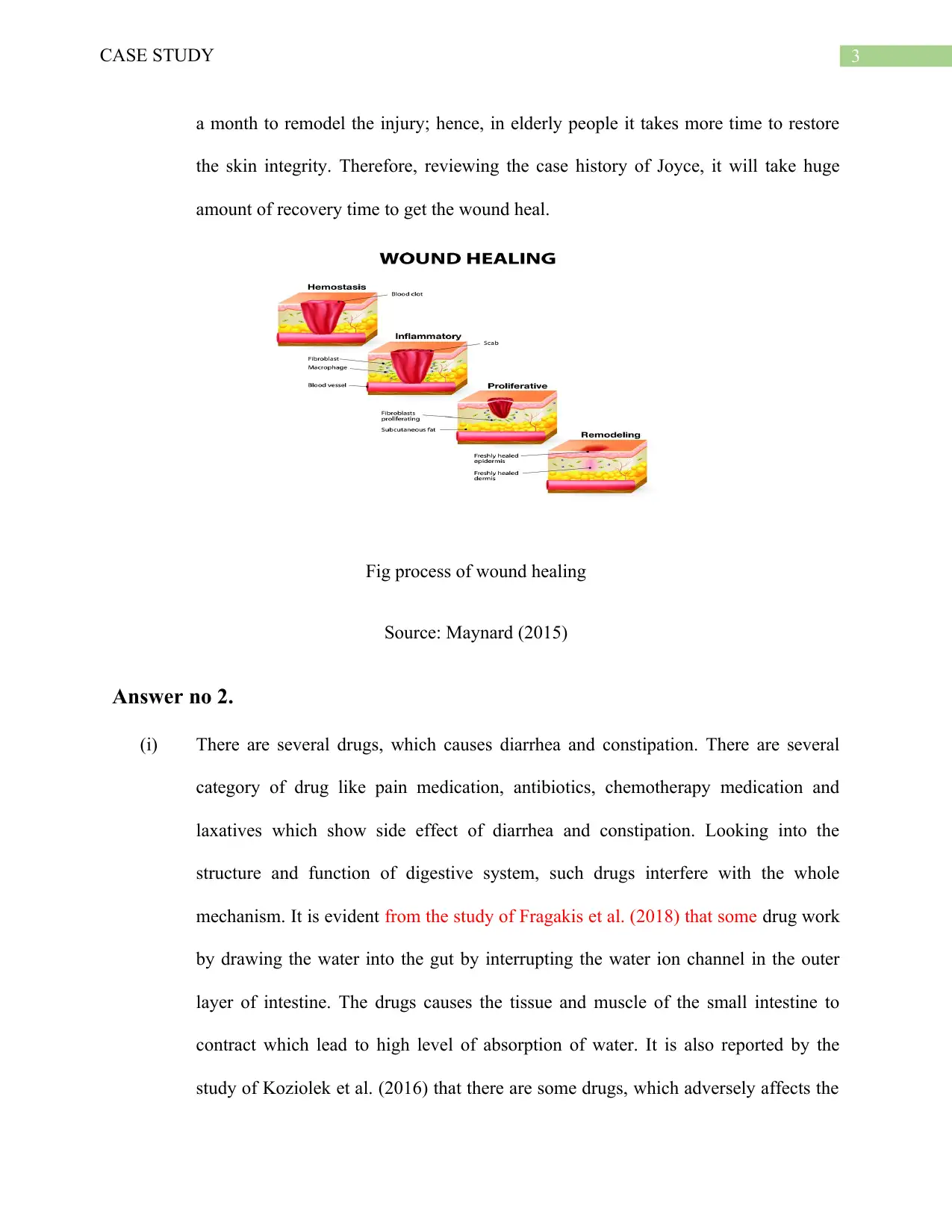
3CASE STUDY
a month to remodel the injury; hence, in elderly people it takes more time to restore
the skin integrity. Therefore, reviewing the case history of Joyce, it will take huge
amount of recovery time to get the wound heal.
Fig process of wound healing
Source: Maynard (2015)
Answer no 2.
(i) There are several drugs, which causes diarrhea and constipation. There are several
category of drug like pain medication, antibiotics, chemotherapy medication and
laxatives which show side effect of diarrhea and constipation. Looking into the
structure and function of digestive system, such drugs interfere with the whole
mechanism. It is evident from the study of Fragakis et al. (2018) that some drug work
by drawing the water into the gut by interrupting the water ion channel in the outer
layer of intestine. The drugs causes the tissue and muscle of the small intestine to
contract which lead to high level of absorption of water. It is also reported by the
study of Koziolek et al. (2016) that there are some drugs, which adversely affects the
a month to remodel the injury; hence, in elderly people it takes more time to restore
the skin integrity. Therefore, reviewing the case history of Joyce, it will take huge
amount of recovery time to get the wound heal.
Fig process of wound healing
Source: Maynard (2015)
Answer no 2.
(i) There are several drugs, which causes diarrhea and constipation. There are several
category of drug like pain medication, antibiotics, chemotherapy medication and
laxatives which show side effect of diarrhea and constipation. Looking into the
structure and function of digestive system, such drugs interfere with the whole
mechanism. It is evident from the study of Fragakis et al. (2018) that some drug work
by drawing the water into the gut by interrupting the water ion channel in the outer
layer of intestine. The drugs causes the tissue and muscle of the small intestine to
contract which lead to high level of absorption of water. It is also reported by the
study of Koziolek et al. (2016) that there are some drugs, which adversely affects the
Paraphrase This Document
Need a fresh take? Get an instant paraphrase of this document with our AI Paraphraser
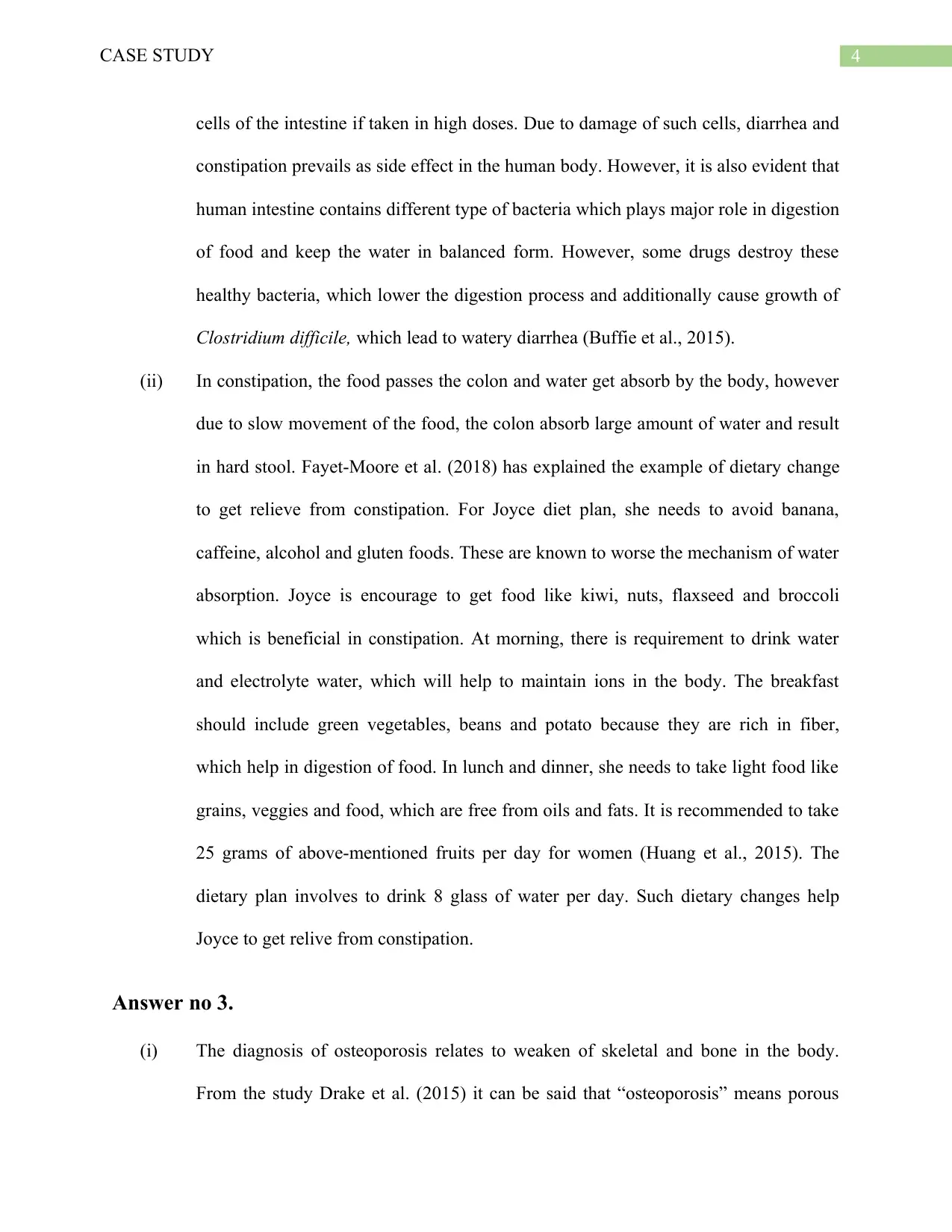
4CASE STUDY
cells of the intestine if taken in high doses. Due to damage of such cells, diarrhea and
constipation prevails as side effect in the human body. However, it is also evident that
human intestine contains different type of bacteria which plays major role in digestion
of food and keep the water in balanced form. However, some drugs destroy these
healthy bacteria, which lower the digestion process and additionally cause growth of
Clostridium difficile, which lead to watery diarrhea (Buffie et al., 2015).
(ii) In constipation, the food passes the colon and water get absorb by the body, however
due to slow movement of the food, the colon absorb large amount of water and result
in hard stool. Fayet-Moore et al. (2018) has explained the example of dietary change
to get relieve from constipation. For Joyce diet plan, she needs to avoid banana,
caffeine, alcohol and gluten foods. These are known to worse the mechanism of water
absorption. Joyce is encourage to get food like kiwi, nuts, flaxseed and broccoli
which is beneficial in constipation. At morning, there is requirement to drink water
and electrolyte water, which will help to maintain ions in the body. The breakfast
should include green vegetables, beans and potato because they are rich in fiber,
which help in digestion of food. In lunch and dinner, she needs to take light food like
grains, veggies and food, which are free from oils and fats. It is recommended to take
25 grams of above-mentioned fruits per day for women (Huang et al., 2015). The
dietary plan involves to drink 8 glass of water per day. Such dietary changes help
Joyce to get relive from constipation.
Answer no 3.
(i) The diagnosis of osteoporosis relates to weaken of skeletal and bone in the body.
From the study Drake et al. (2015) it can be said that “osteoporosis” means porous
cells of the intestine if taken in high doses. Due to damage of such cells, diarrhea and
constipation prevails as side effect in the human body. However, it is also evident that
human intestine contains different type of bacteria which plays major role in digestion
of food and keep the water in balanced form. However, some drugs destroy these
healthy bacteria, which lower the digestion process and additionally cause growth of
Clostridium difficile, which lead to watery diarrhea (Buffie et al., 2015).
(ii) In constipation, the food passes the colon and water get absorb by the body, however
due to slow movement of the food, the colon absorb large amount of water and result
in hard stool. Fayet-Moore et al. (2018) has explained the example of dietary change
to get relieve from constipation. For Joyce diet plan, she needs to avoid banana,
caffeine, alcohol and gluten foods. These are known to worse the mechanism of water
absorption. Joyce is encourage to get food like kiwi, nuts, flaxseed and broccoli
which is beneficial in constipation. At morning, there is requirement to drink water
and electrolyte water, which will help to maintain ions in the body. The breakfast
should include green vegetables, beans and potato because they are rich in fiber,
which help in digestion of food. In lunch and dinner, she needs to take light food like
grains, veggies and food, which are free from oils and fats. It is recommended to take
25 grams of above-mentioned fruits per day for women (Huang et al., 2015). The
dietary plan involves to drink 8 glass of water per day. Such dietary changes help
Joyce to get relive from constipation.
Answer no 3.
(i) The diagnosis of osteoporosis relates to weaken of skeletal and bone in the body.
From the study Drake et al. (2015) it can be said that “osteoporosis” means porous
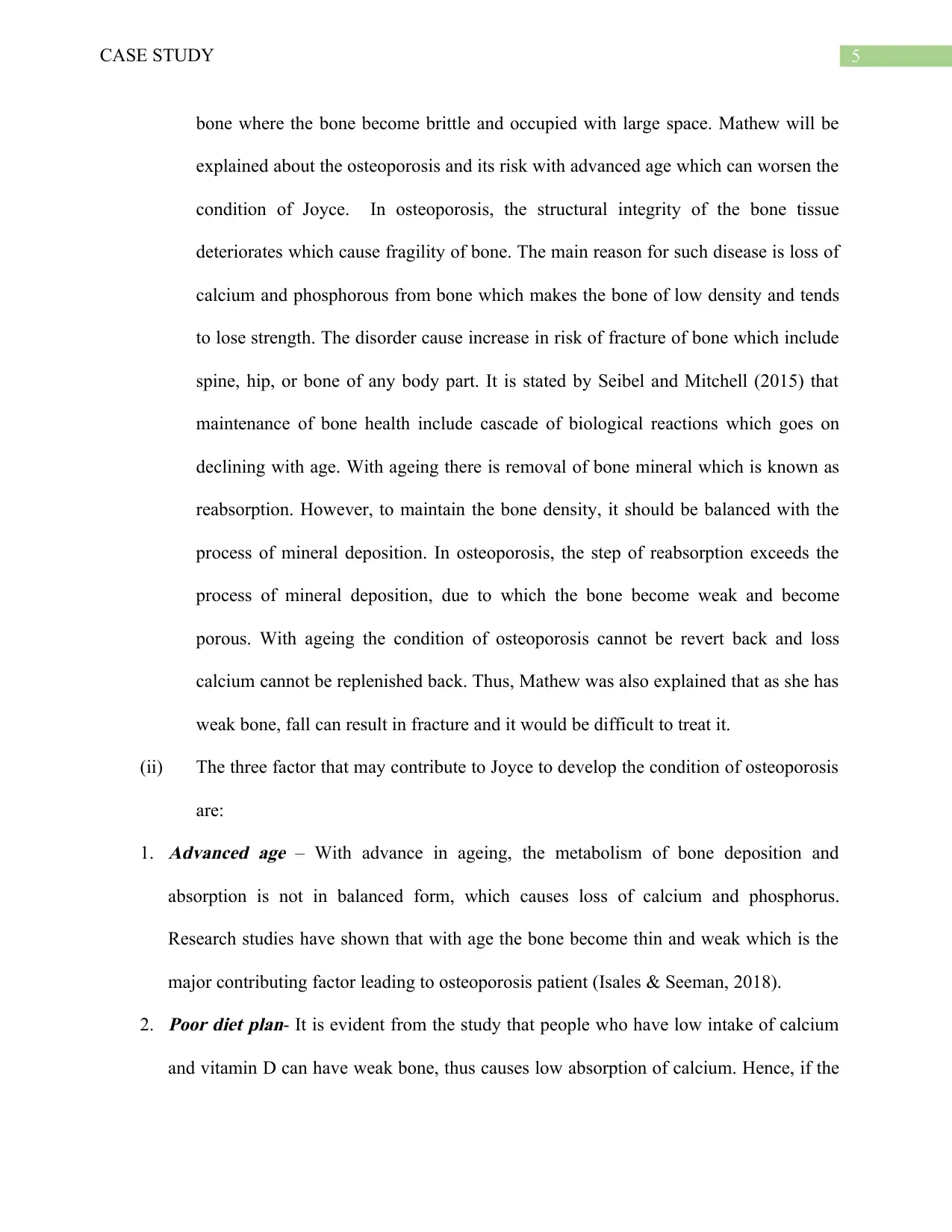
5CASE STUDY
bone where the bone become brittle and occupied with large space. Mathew will be
explained about the osteoporosis and its risk with advanced age which can worsen the
condition of Joyce. In osteoporosis, the structural integrity of the bone tissue
deteriorates which cause fragility of bone. The main reason for such disease is loss of
calcium and phosphorous from bone which makes the bone of low density and tends
to lose strength. The disorder cause increase in risk of fracture of bone which include
spine, hip, or bone of any body part. It is stated by Seibel and Mitchell (2015) that
maintenance of bone health include cascade of biological reactions which goes on
declining with age. With ageing there is removal of bone mineral which is known as
reabsorption. However, to maintain the bone density, it should be balanced with the
process of mineral deposition. In osteoporosis, the step of reabsorption exceeds the
process of mineral deposition, due to which the bone become weak and become
porous. With ageing the condition of osteoporosis cannot be revert back and loss
calcium cannot be replenished back. Thus, Mathew was also explained that as she has
weak bone, fall can result in fracture and it would be difficult to treat it.
(ii) The three factor that may contribute to Joyce to develop the condition of osteoporosis
are:
1.
Advanced age – With advance in ageing, the metabolism of bone deposition and
absorption is not in balanced form, which causes loss of calcium and phosphorus.
Research studies have shown that with age the bone become thin and weak which is the
major contributing factor leading to osteoporosis patient (Isales & Seeman, 2018).
2.
Poor diet plan- It is evident from the study that people who have low intake of calcium
and vitamin D can have weak bone, thus causes low absorption of calcium. Hence, if the
bone where the bone become brittle and occupied with large space. Mathew will be
explained about the osteoporosis and its risk with advanced age which can worsen the
condition of Joyce. In osteoporosis, the structural integrity of the bone tissue
deteriorates which cause fragility of bone. The main reason for such disease is loss of
calcium and phosphorous from bone which makes the bone of low density and tends
to lose strength. The disorder cause increase in risk of fracture of bone which include
spine, hip, or bone of any body part. It is stated by Seibel and Mitchell (2015) that
maintenance of bone health include cascade of biological reactions which goes on
declining with age. With ageing there is removal of bone mineral which is known as
reabsorption. However, to maintain the bone density, it should be balanced with the
process of mineral deposition. In osteoporosis, the step of reabsorption exceeds the
process of mineral deposition, due to which the bone become weak and become
porous. With ageing the condition of osteoporosis cannot be revert back and loss
calcium cannot be replenished back. Thus, Mathew was also explained that as she has
weak bone, fall can result in fracture and it would be difficult to treat it.
(ii) The three factor that may contribute to Joyce to develop the condition of osteoporosis
are:
1.
Advanced age – With advance in ageing, the metabolism of bone deposition and
absorption is not in balanced form, which causes loss of calcium and phosphorus.
Research studies have shown that with age the bone become thin and weak which is the
major contributing factor leading to osteoporosis patient (Isales & Seeman, 2018).
2.
Poor diet plan- It is evident from the study that people who have low intake of calcium
and vitamin D can have weak bone, thus causes low absorption of calcium. Hence, if the
⊘ This is a preview!⊘
Do you want full access?
Subscribe today to unlock all pages.

Trusted by 1+ million students worldwide
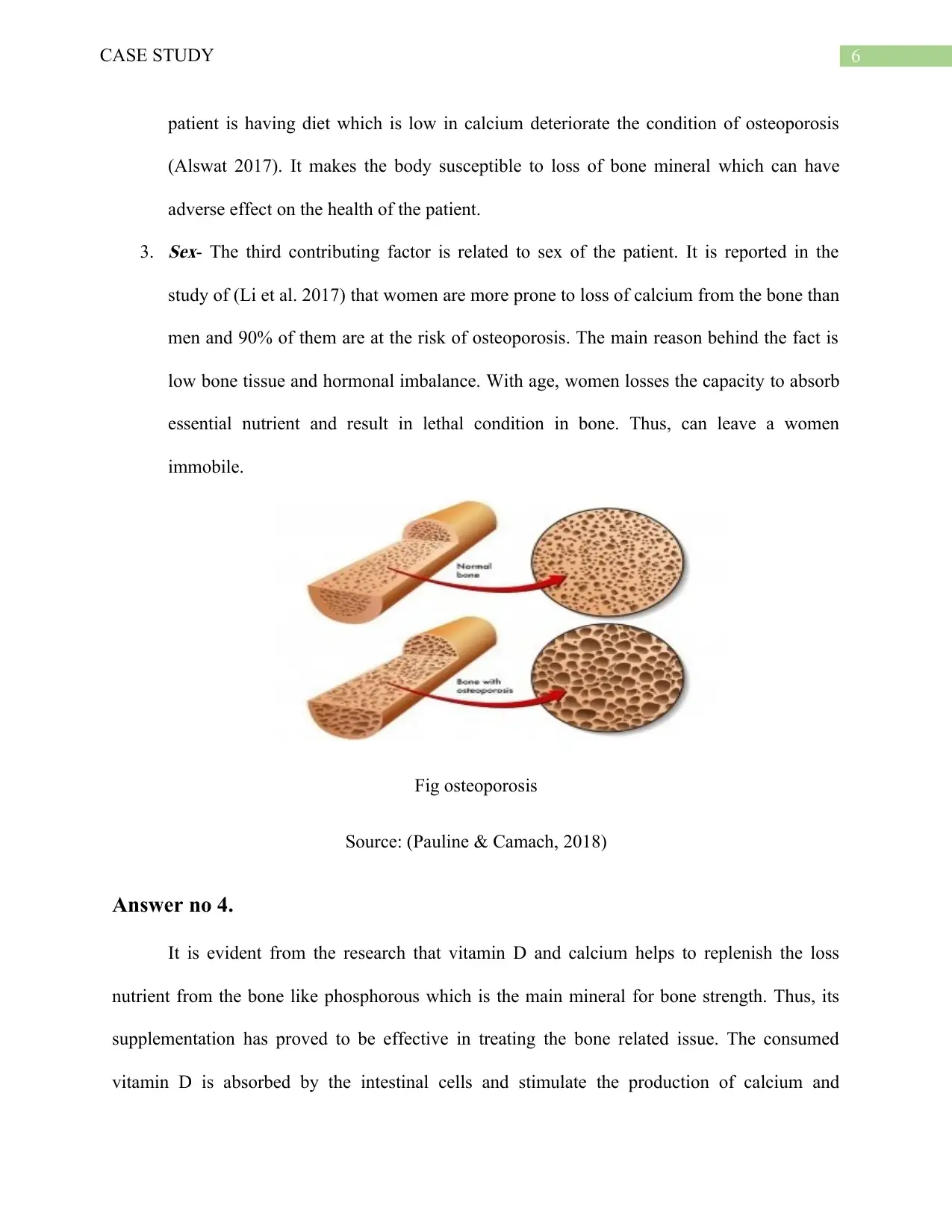
6CASE STUDY
patient is having diet which is low in calcium deteriorate the condition of osteoporosis
(Alswat 2017). It makes the body susceptible to loss of bone mineral which can have
adverse effect on the health of the patient.
3.
Sex- The third contributing factor is related to sex of the patient. It is reported in the
study of (Li et al. 2017) that women are more prone to loss of calcium from the bone than
men and 90% of them are at the risk of osteoporosis. The main reason behind the fact is
low bone tissue and hormonal imbalance. With age, women losses the capacity to absorb
essential nutrient and result in lethal condition in bone. Thus, can leave a women
immobile.
Fig osteoporosis
Source: (Pauline & Camach, 2018)
Answer no 4.
It is evident from the research that vitamin D and calcium helps to replenish the loss
nutrient from the bone like phosphorous which is the main mineral for bone strength. Thus, its
supplementation has proved to be effective in treating the bone related issue. The consumed
vitamin D is absorbed by the intestinal cells and stimulate the production of calcium and
patient is having diet which is low in calcium deteriorate the condition of osteoporosis
(Alswat 2017). It makes the body susceptible to loss of bone mineral which can have
adverse effect on the health of the patient.
3.
Sex- The third contributing factor is related to sex of the patient. It is reported in the
study of (Li et al. 2017) that women are more prone to loss of calcium from the bone than
men and 90% of them are at the risk of osteoporosis. The main reason behind the fact is
low bone tissue and hormonal imbalance. With age, women losses the capacity to absorb
essential nutrient and result in lethal condition in bone. Thus, can leave a women
immobile.
Fig osteoporosis
Source: (Pauline & Camach, 2018)
Answer no 4.
It is evident from the research that vitamin D and calcium helps to replenish the loss
nutrient from the bone like phosphorous which is the main mineral for bone strength. Thus, its
supplementation has proved to be effective in treating the bone related issue. The consumed
vitamin D is absorbed by the intestinal cells and stimulate the production of calcium and
Paraphrase This Document
Need a fresh take? Get an instant paraphrase of this document with our AI Paraphraser
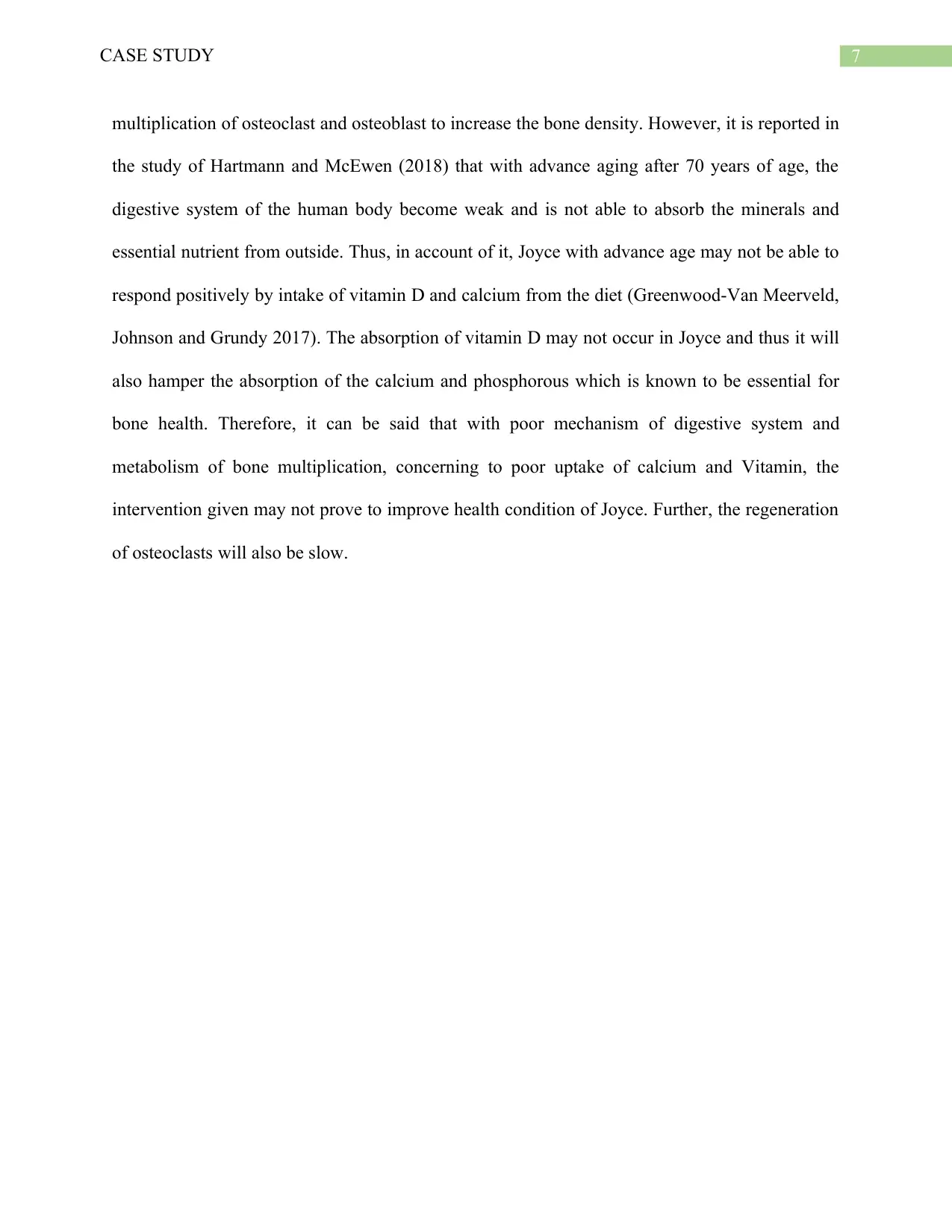
7CASE STUDY
multiplication of osteoclast and osteoblast to increase the bone density. However, it is reported in
the study of Hartmann and McEwen (2018) that with advance aging after 70 years of age, the
digestive system of the human body become weak and is not able to absorb the minerals and
essential nutrient from outside. Thus, in account of it, Joyce with advance age may not be able to
respond positively by intake of vitamin D and calcium from the diet (Greenwood-Van Meerveld,
Johnson and Grundy 2017). The absorption of vitamin D may not occur in Joyce and thus it will
also hamper the absorption of the calcium and phosphorous which is known to be essential for
bone health. Therefore, it can be said that with poor mechanism of digestive system and
metabolism of bone multiplication, concerning to poor uptake of calcium and Vitamin, the
intervention given may not prove to improve health condition of Joyce. Further, the regeneration
of osteoclasts will also be slow.
multiplication of osteoclast and osteoblast to increase the bone density. However, it is reported in
the study of Hartmann and McEwen (2018) that with advance aging after 70 years of age, the
digestive system of the human body become weak and is not able to absorb the minerals and
essential nutrient from outside. Thus, in account of it, Joyce with advance age may not be able to
respond positively by intake of vitamin D and calcium from the diet (Greenwood-Van Meerveld,
Johnson and Grundy 2017). The absorption of vitamin D may not occur in Joyce and thus it will
also hamper the absorption of the calcium and phosphorous which is known to be essential for
bone health. Therefore, it can be said that with poor mechanism of digestive system and
metabolism of bone multiplication, concerning to poor uptake of calcium and Vitamin, the
intervention given may not prove to improve health condition of Joyce. Further, the regeneration
of osteoclasts will also be slow.
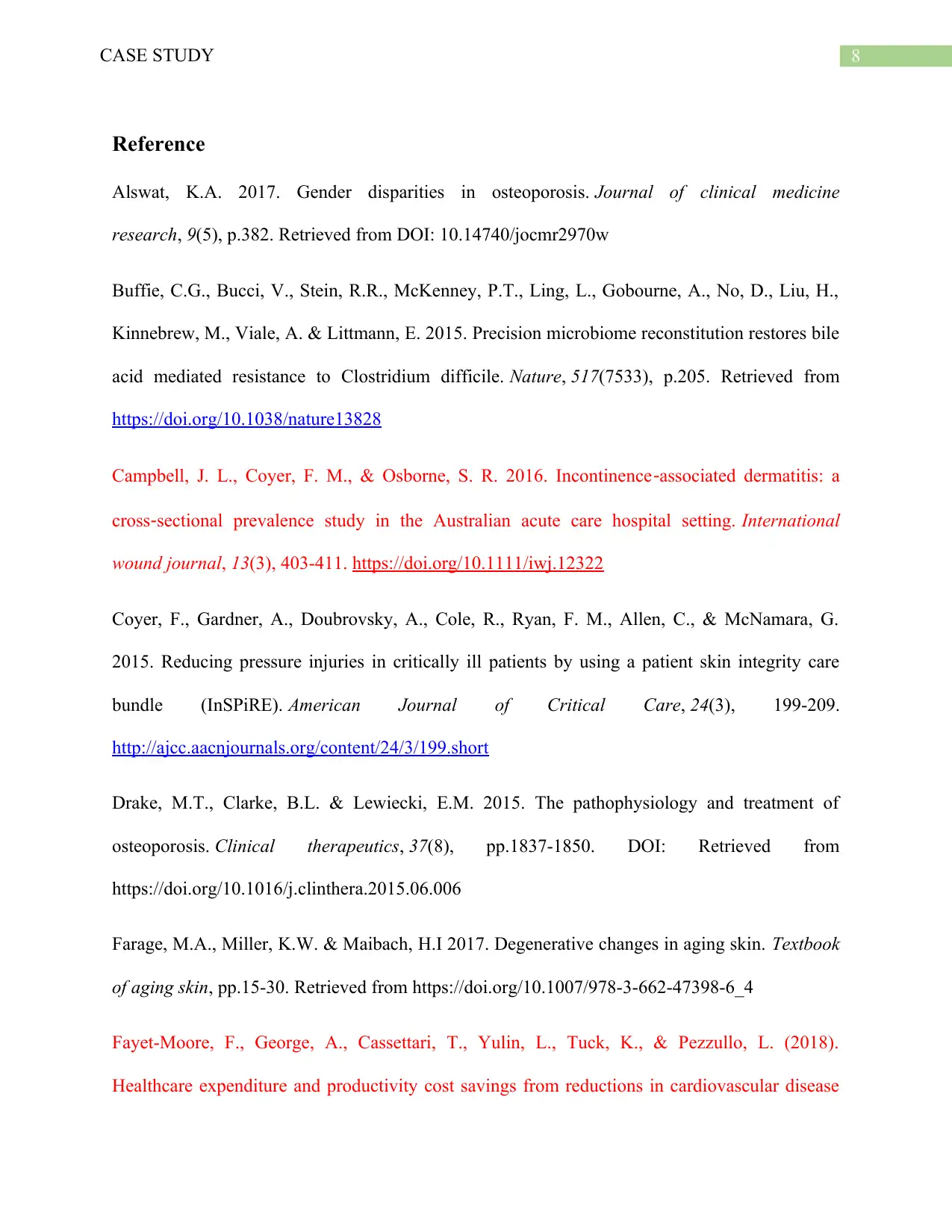
8CASE STUDY
Reference
Alswat, K.A. 2017. Gender disparities in osteoporosis. Journal of clinical medicine
research, 9(5), p.382. Retrieved from DOI: 10.14740/jocmr2970w
Buffie, C.G., Bucci, V., Stein, R.R., McKenney, P.T., Ling, L., Gobourne, A., No, D., Liu, H.,
Kinnebrew, M., Viale, A. & Littmann, E. 2015. Precision microbiome reconstitution restores bile
acid mediated resistance to Clostridium difficile. Nature, 517(7533), p.205. Retrieved from
https://doi.org/10.1038/nature13828
Campbell, J. L., Coyer, F. M., & Osborne, S. R. 2016. Incontinence‐associated dermatitis: a
cross‐sectional prevalence study in the Australian acute care hospital setting. International
wound journal, 13(3), 403-411. https://doi.org/10.1111/iwj.12322
Coyer, F., Gardner, A., Doubrovsky, A., Cole, R., Ryan, F. M., Allen, C., & McNamara, G.
2015. Reducing pressure injuries in critically ill patients by using a patient skin integrity care
bundle (InSPiRE). American Journal of Critical Care, 24(3), 199-209.
http://ajcc.aacnjournals.org/content/24/3/199.short
Drake, M.T., Clarke, B.L. & Lewiecki, E.M. 2015. The pathophysiology and treatment of
osteoporosis. Clinical therapeutics, 37(8), pp.1837-1850. DOI: Retrieved from
https://doi.org/10.1016/j.clinthera.2015.06.006
Farage, M.A., Miller, K.W. & Maibach, H.I 2017. Degenerative changes in aging skin. Textbook
of aging skin, pp.15-30. Retrieved from https://doi.org/10.1007/978-3-662-47398-6_4
Fayet-Moore, F., George, A., Cassettari, T., Yulin, L., Tuck, K., & Pezzullo, L. (2018).
Healthcare expenditure and productivity cost savings from reductions in cardiovascular disease
Reference
Alswat, K.A. 2017. Gender disparities in osteoporosis. Journal of clinical medicine
research, 9(5), p.382. Retrieved from DOI: 10.14740/jocmr2970w
Buffie, C.G., Bucci, V., Stein, R.R., McKenney, P.T., Ling, L., Gobourne, A., No, D., Liu, H.,
Kinnebrew, M., Viale, A. & Littmann, E. 2015. Precision microbiome reconstitution restores bile
acid mediated resistance to Clostridium difficile. Nature, 517(7533), p.205. Retrieved from
https://doi.org/10.1038/nature13828
Campbell, J. L., Coyer, F. M., & Osborne, S. R. 2016. Incontinence‐associated dermatitis: a
cross‐sectional prevalence study in the Australian acute care hospital setting. International
wound journal, 13(3), 403-411. https://doi.org/10.1111/iwj.12322
Coyer, F., Gardner, A., Doubrovsky, A., Cole, R., Ryan, F. M., Allen, C., & McNamara, G.
2015. Reducing pressure injuries in critically ill patients by using a patient skin integrity care
bundle (InSPiRE). American Journal of Critical Care, 24(3), 199-209.
http://ajcc.aacnjournals.org/content/24/3/199.short
Drake, M.T., Clarke, B.L. & Lewiecki, E.M. 2015. The pathophysiology and treatment of
osteoporosis. Clinical therapeutics, 37(8), pp.1837-1850. DOI: Retrieved from
https://doi.org/10.1016/j.clinthera.2015.06.006
Farage, M.A., Miller, K.W. & Maibach, H.I 2017. Degenerative changes in aging skin. Textbook
of aging skin, pp.15-30. Retrieved from https://doi.org/10.1007/978-3-662-47398-6_4
Fayet-Moore, F., George, A., Cassettari, T., Yulin, L., Tuck, K., & Pezzullo, L. (2018).
Healthcare expenditure and productivity cost savings from reductions in cardiovascular disease
⊘ This is a preview!⊘
Do you want full access?
Subscribe today to unlock all pages.

Trusted by 1+ million students worldwide
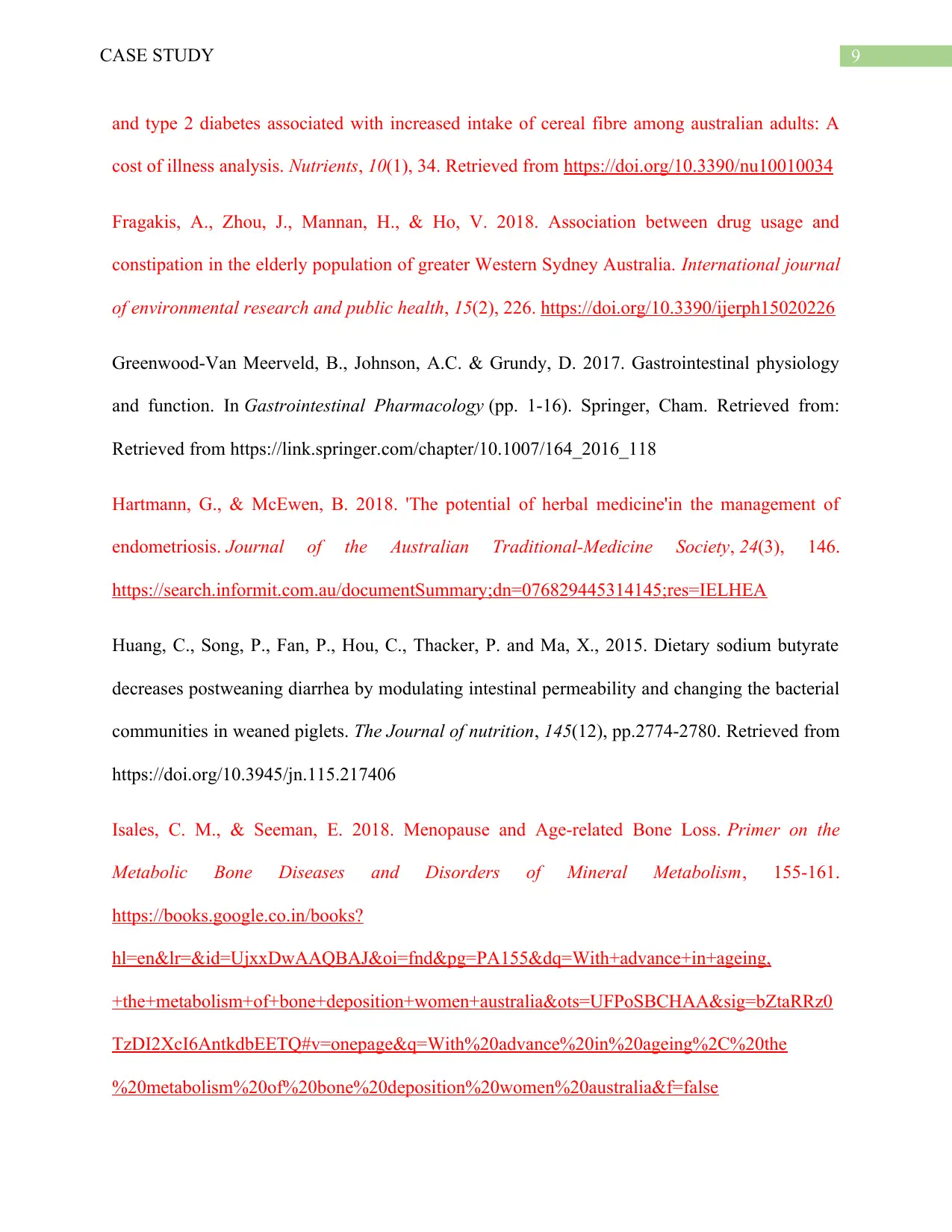
9CASE STUDY
and type 2 diabetes associated with increased intake of cereal fibre among australian adults: A
cost of illness analysis. Nutrients, 10(1), 34. Retrieved from https://doi.org/10.3390/nu10010034
Fragakis, A., Zhou, J., Mannan, H., & Ho, V. 2018. Association between drug usage and
constipation in the elderly population of greater Western Sydney Australia. International journal
of environmental research and public health, 15(2), 226. https://doi.org/10.3390/ijerph15020226
Greenwood-Van Meerveld, B., Johnson, A.C. & Grundy, D. 2017. Gastrointestinal physiology
and function. In Gastrointestinal Pharmacology (pp. 1-16). Springer, Cham. Retrieved from:
Retrieved from https://link.springer.com/chapter/10.1007/164_2016_118
Hartmann, G., & McEwen, B. 2018. 'The potential of herbal medicine'in the management of
endometriosis. Journal of the Australian Traditional-Medicine Society, 24(3), 146.
https://search.informit.com.au/documentSummary;dn=076829445314145;res=IELHEA
Huang, C., Song, P., Fan, P., Hou, C., Thacker, P. and Ma, X., 2015. Dietary sodium butyrate
decreases postweaning diarrhea by modulating intestinal permeability and changing the bacterial
communities in weaned piglets. The Journal of nutrition, 145(12), pp.2774-2780. Retrieved from
https://doi.org/10.3945/jn.115.217406
Isales, C. M., & Seeman, E. 2018. Menopause and Age‐related Bone Loss. Primer on the
Metabolic Bone Diseases and Disorders of Mineral Metabolism, 155-161.
https://books.google.co.in/books?
hl=en&lr=&id=UjxxDwAAQBAJ&oi=fnd&pg=PA155&dq=With+advance+in+ageing,
+the+metabolism+of+bone+deposition+women+australia&ots=UFPoSBCHAA&sig=bZtaRRz0
TzDI2XcI6AntkdbEETQ#v=onepage&q=With%20advance%20in%20ageing%2C%20the
%20metabolism%20of%20bone%20deposition%20women%20australia&f=false
and type 2 diabetes associated with increased intake of cereal fibre among australian adults: A
cost of illness analysis. Nutrients, 10(1), 34. Retrieved from https://doi.org/10.3390/nu10010034
Fragakis, A., Zhou, J., Mannan, H., & Ho, V. 2018. Association between drug usage and
constipation in the elderly population of greater Western Sydney Australia. International journal
of environmental research and public health, 15(2), 226. https://doi.org/10.3390/ijerph15020226
Greenwood-Van Meerveld, B., Johnson, A.C. & Grundy, D. 2017. Gastrointestinal physiology
and function. In Gastrointestinal Pharmacology (pp. 1-16). Springer, Cham. Retrieved from:
Retrieved from https://link.springer.com/chapter/10.1007/164_2016_118
Hartmann, G., & McEwen, B. 2018. 'The potential of herbal medicine'in the management of
endometriosis. Journal of the Australian Traditional-Medicine Society, 24(3), 146.
https://search.informit.com.au/documentSummary;dn=076829445314145;res=IELHEA
Huang, C., Song, P., Fan, P., Hou, C., Thacker, P. and Ma, X., 2015. Dietary sodium butyrate
decreases postweaning diarrhea by modulating intestinal permeability and changing the bacterial
communities in weaned piglets. The Journal of nutrition, 145(12), pp.2774-2780. Retrieved from
https://doi.org/10.3945/jn.115.217406
Isales, C. M., & Seeman, E. 2018. Menopause and Age‐related Bone Loss. Primer on the
Metabolic Bone Diseases and Disorders of Mineral Metabolism, 155-161.
https://books.google.co.in/books?
hl=en&lr=&id=UjxxDwAAQBAJ&oi=fnd&pg=PA155&dq=With+advance+in+ageing,
+the+metabolism+of+bone+deposition+women+australia&ots=UFPoSBCHAA&sig=bZtaRRz0
TzDI2XcI6AntkdbEETQ#v=onepage&q=With%20advance%20in%20ageing%2C%20the
%20metabolism%20of%20bone%20deposition%20women%20australia&f=false
Paraphrase This Document
Need a fresh take? Get an instant paraphrase of this document with our AI Paraphraser
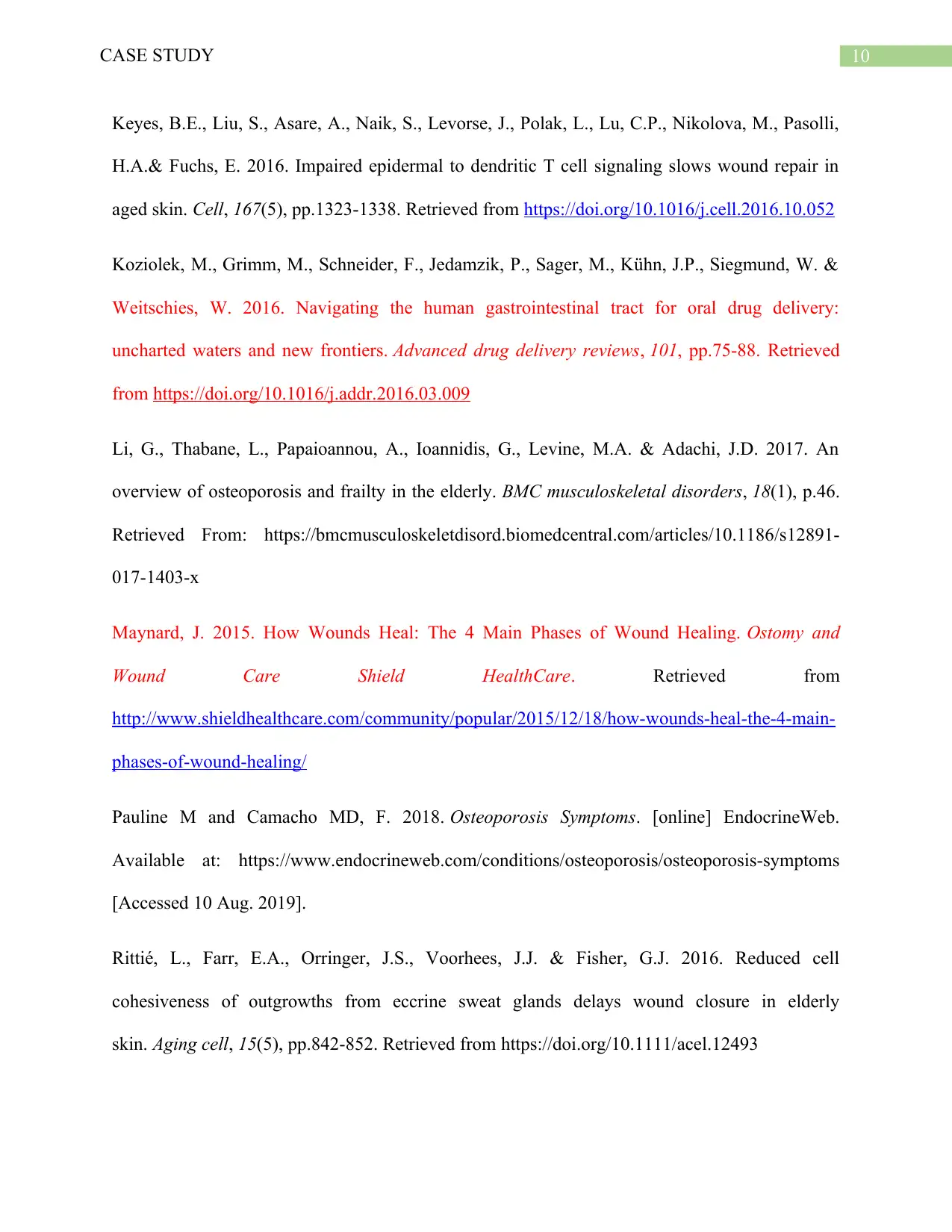
10CASE STUDY
Keyes, B.E., Liu, S., Asare, A., Naik, S., Levorse, J., Polak, L., Lu, C.P., Nikolova, M., Pasolli,
H.A.& Fuchs, E. 2016. Impaired epidermal to dendritic T cell signaling slows wound repair in
aged skin. Cell, 167(5), pp.1323-1338. Retrieved from https://doi.org/10.1016/j.cell.2016.10.052
Koziolek, M., Grimm, M., Schneider, F., Jedamzik, P., Sager, M., Kühn, J.P., Siegmund, W. &
Weitschies, W. 2016. Navigating the human gastrointestinal tract for oral drug delivery:
uncharted waters and new frontiers. Advanced drug delivery reviews, 101, pp.75-88. Retrieved
from https://doi.org/10.1016/j.addr.2016.03.009
Li, G., Thabane, L., Papaioannou, A., Ioannidis, G., Levine, M.A. & Adachi, J.D. 2017. An
overview of osteoporosis and frailty in the elderly. BMC musculoskeletal disorders, 18(1), p.46.
Retrieved From: https://bmcmusculoskeletdisord.biomedcentral.com/articles/10.1186/s12891-
017-1403-x
Maynard, J. 2015. How Wounds Heal: The 4 Main Phases of Wound Healing. Ostomy and
Wound Care Shield HealthCare. Retrieved from
http://www.shieldhealthcare.com/community/popular/2015/12/18/how-wounds-heal-the-4-main-
phases-of-wound-healing/
Pauline M and Camacho MD, F. 2018. Osteoporosis Symptoms. [online] EndocrineWeb.
Available at: https://www.endocrineweb.com/conditions/osteoporosis/osteoporosis-symptoms
[Accessed 10 Aug. 2019].
Rittié, L., Farr, E.A., Orringer, J.S., Voorhees, J.J. & Fisher, G.J. 2016. Reduced cell
cohesiveness of outgrowths from eccrine sweat glands delays wound closure in elderly
skin. Aging cell, 15(5), pp.842-852. Retrieved from https://doi.org/10.1111/acel.12493
Keyes, B.E., Liu, S., Asare, A., Naik, S., Levorse, J., Polak, L., Lu, C.P., Nikolova, M., Pasolli,
H.A.& Fuchs, E. 2016. Impaired epidermal to dendritic T cell signaling slows wound repair in
aged skin. Cell, 167(5), pp.1323-1338. Retrieved from https://doi.org/10.1016/j.cell.2016.10.052
Koziolek, M., Grimm, M., Schneider, F., Jedamzik, P., Sager, M., Kühn, J.P., Siegmund, W. &
Weitschies, W. 2016. Navigating the human gastrointestinal tract for oral drug delivery:
uncharted waters and new frontiers. Advanced drug delivery reviews, 101, pp.75-88. Retrieved
from https://doi.org/10.1016/j.addr.2016.03.009
Li, G., Thabane, L., Papaioannou, A., Ioannidis, G., Levine, M.A. & Adachi, J.D. 2017. An
overview of osteoporosis and frailty in the elderly. BMC musculoskeletal disorders, 18(1), p.46.
Retrieved From: https://bmcmusculoskeletdisord.biomedcentral.com/articles/10.1186/s12891-
017-1403-x
Maynard, J. 2015. How Wounds Heal: The 4 Main Phases of Wound Healing. Ostomy and
Wound Care Shield HealthCare. Retrieved from
http://www.shieldhealthcare.com/community/popular/2015/12/18/how-wounds-heal-the-4-main-
phases-of-wound-healing/
Pauline M and Camacho MD, F. 2018. Osteoporosis Symptoms. [online] EndocrineWeb.
Available at: https://www.endocrineweb.com/conditions/osteoporosis/osteoporosis-symptoms
[Accessed 10 Aug. 2019].
Rittié, L., Farr, E.A., Orringer, J.S., Voorhees, J.J. & Fisher, G.J. 2016. Reduced cell
cohesiveness of outgrowths from eccrine sweat glands delays wound closure in elderly
skin. Aging cell, 15(5), pp.842-852. Retrieved from https://doi.org/10.1111/acel.12493
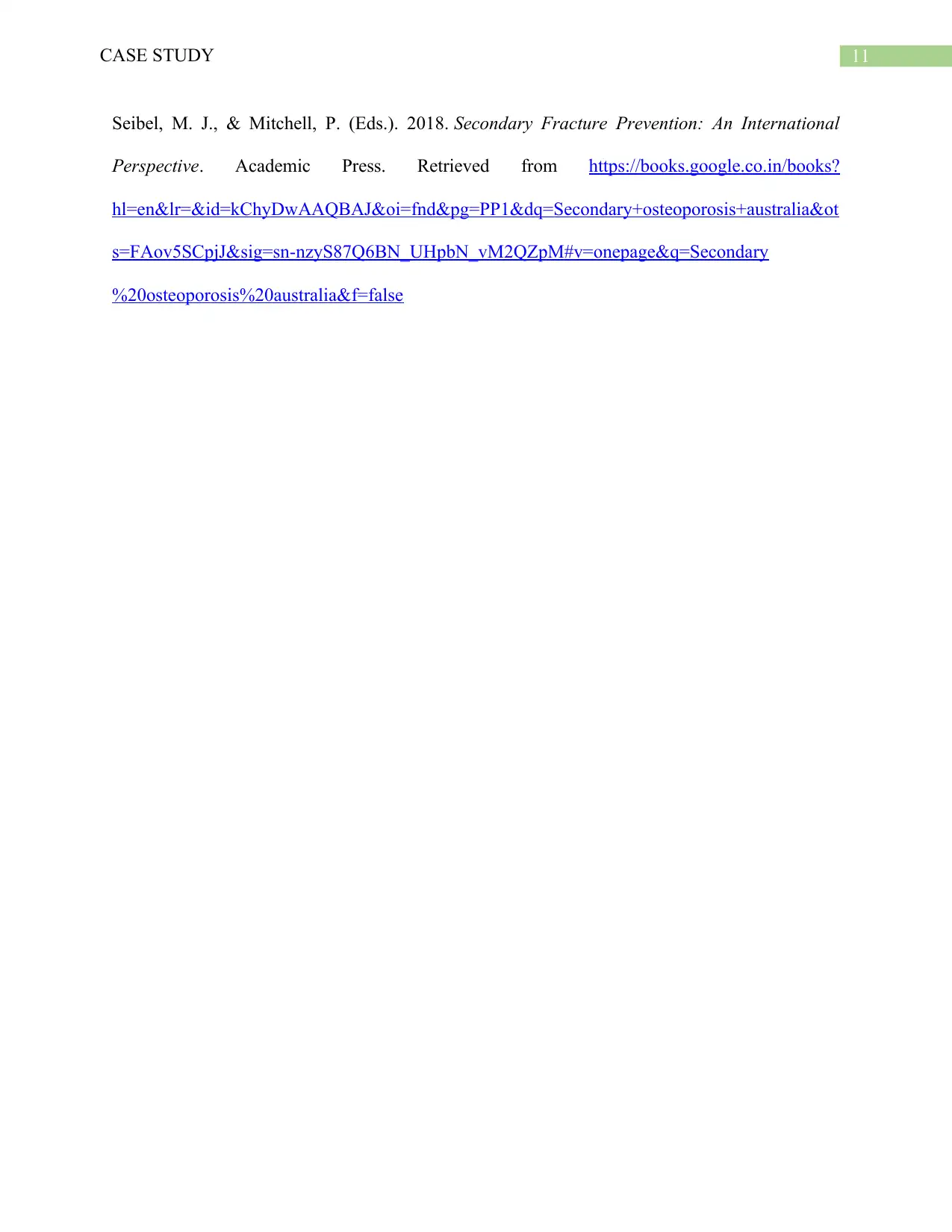
11CASE STUDY
Seibel, M. J., & Mitchell, P. (Eds.). 2018. Secondary Fracture Prevention: An International
Perspective. Academic Press. Retrieved from https://books.google.co.in/books?
hl=en&lr=&id=kChyDwAAQBAJ&oi=fnd&pg=PP1&dq=Secondary+osteoporosis+australia&ot
s=FAov5SCpjJ&sig=sn-nzyS87Q6BN_UHpbN_vM2QZpM#v=onepage&q=Secondary
%20osteoporosis%20australia&f=false
Seibel, M. J., & Mitchell, P. (Eds.). 2018. Secondary Fracture Prevention: An International
Perspective. Academic Press. Retrieved from https://books.google.co.in/books?
hl=en&lr=&id=kChyDwAAQBAJ&oi=fnd&pg=PP1&dq=Secondary+osteoporosis+australia&ot
s=FAov5SCpjJ&sig=sn-nzyS87Q6BN_UHpbN_vM2QZpM#v=onepage&q=Secondary
%20osteoporosis%20australia&f=false
⊘ This is a preview!⊘
Do you want full access?
Subscribe today to unlock all pages.

Trusted by 1+ million students worldwide
1 out of 12
Related Documents
Your All-in-One AI-Powered Toolkit for Academic Success.
+13062052269
info@desklib.com
Available 24*7 on WhatsApp / Email
![[object Object]](/_next/static/media/star-bottom.7253800d.svg)
Unlock your academic potential
Copyright © 2020–2025 A2Z Services. All Rights Reserved. Developed and managed by ZUCOL.





